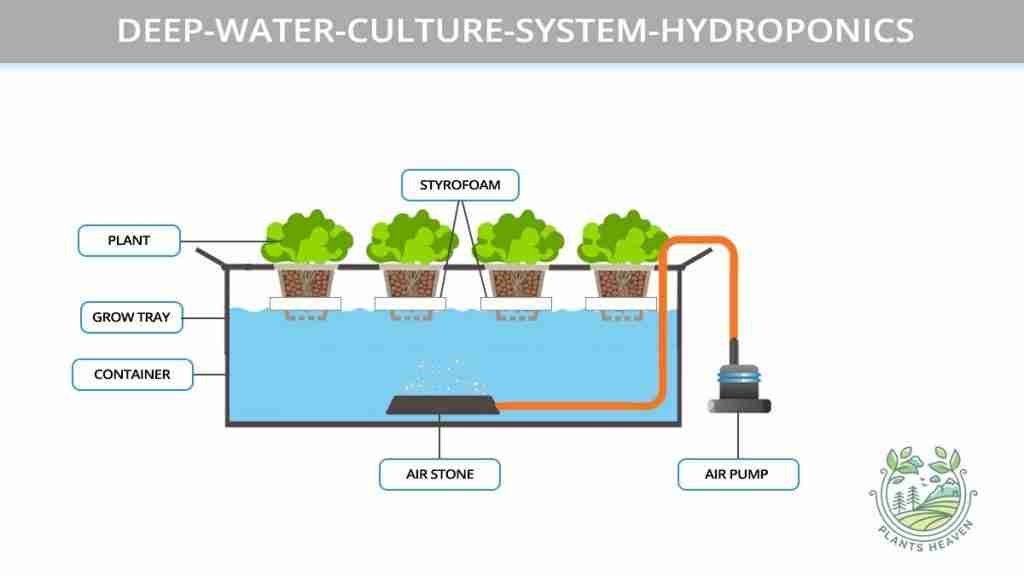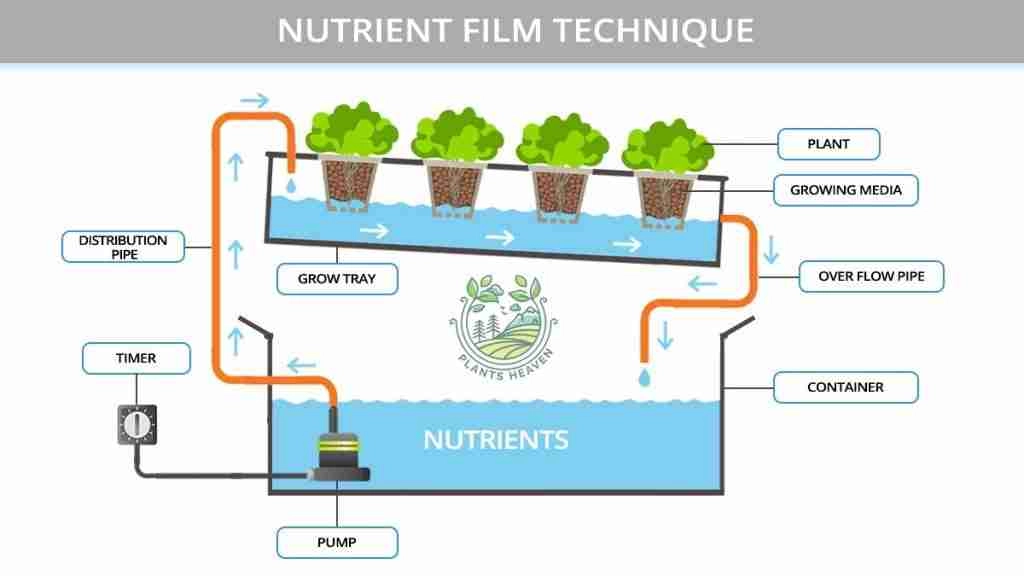NFT and DWC Hydroponics are among the six types of hydroponics systems and have pros and cons. However, you may be wondering what the difference between NFT and DWC hydroponics is and which one is better for you is?
Deep Water Culture (DWC) is more user-friendly, especially if you are a first-time hydroponic grower, because it allows more room for error. The Nutrient Film Technique (NFT) system is more advanced because it requires a bit closer monitoring, especially in case of a power outage. It is simple and easier to maintain a stable fertilizer solution temperature in a DWC system than in an NFT system.
Keep reading to find out everything you need to know about the difference between NFT and DWC hydroponics and be able to choose the one that suits you best for a successful and hassle-free hydroponics journey.
See also: Drip System Hydroponics Pros and Cons (And how to avoid them)
What is the Deep Water Culture (DWC) System?
Deep water culture hydroponics, also known as Deep Flow Technique (DFT), is a process of growing plants where you suspend your plants’ roots in an actively oxygenated solution of water and nutrients instead of planting them in soil.
There are several DWC hydroponics systems, but the basics remain the same. And you can make it as simple or as complicated as you want it to be and scale up as you gain experience.
This hydroponics system eliminates many drawbacks of growing plants in soil and results in larger crop yields and faster plant growth. And it is perfect if you are looking to get started with hydroponics, and it is one step up from wick systems in terms of complexity. However, it is still simple enough to be accessible to anyone.
Deep water culture hydroponics is simple because it uses a suitable well-oxygenated water solution to grow plants efficiently with significantly reduced labor requirements than soil-based gardening.
See also: Here are Deep Water Culture Advantages and Disadvantages (And how to fix them)

What is The Nutrient Film Technique (NFT) System?
The nutrient film technique (NFT) is a hydroponic technique where a very shallow stream of water (film), which contains dissolved nutrients needed for plant growth, is recirculated past your plants’ roots in a closely sealed gully known as channels.
Nutrient Film Technique (NFT) uses a sloped trough or tube to drive the nutrient solution through the system. First, the liquid fertilizer solution is pumped from the reservoir to the high side of the inclined plane and flows down through the system.
Finally, the flow of nutrients is returned to the reservoir via a gutter at the low end and is recirculated through the system.
See also: Top 20 Nutrient Film Technique Advantages And Disadvantages – You Need To Be Aware Of

Difference Between NFT and DWC Hydroponics
Both DWC and NFT hydroponics systems offer excellent benefits, and both have disadvantages. Here is a snapshot of the pros and cons of the Deep Water Culture (DWC) System and Nutrient Film Technique (NFT) System compared side by side.
| Material Needed | Benefits | Drawback | |
| NFT system | – Reservoir – Air pump and air stone – Plant channel – Distilled water – Water pump – Net pots – Timer – Nutrient solution | – Nutrient film system saves water – Low cost and maintenance requirements – NFT would be best for lettuce and space – Easy to examine roots for a sign of disease – Constant flow reduces fungal risk | – Nutrient Film Technique may not be beginner-friendly – Extremely Sensitive pump failure – Not compatible with growing larger plants with large root systems – Plant roots can clog the channels – NFT is often considered an active system |
| DWC System | – Reservoir – Air pump and air stone – Distilled water – Growing medium – Nutrient solution – Net pots | – Beginner-friendly – Suitable for growing big-size plants – Better water temperature controlInexpensive and low-cost to maintain – Deep water culture is best for power outages – Will produce more per plant and offers super-fast growth. – Keeping oxygen level in the water is critical | – If you don’t adequately manage your plants’ roots, they can suffocate in solution. – It doesn’t usually work for a longer growing period. – It is challenging to check and refill each bucket |
Is NFT better than DWC?
Deep Water Culture (DWC) is simpler and has a greater volume of water; there are fewer temperature fluctuations. Also, DWC would have less distance for the roots to grow before it touches the water. NFT would provide greater air exchange and possibly give better results overall. It would also use less water and nutrients.
In addition, the DWC is more user-friendly, especially if you are a first-timer hydroponic grower, because there is more room for error. In contrast, the nutrient film technique system growing is more high-level because it requires a bit closer monitoring, especially if you experience a power outage. It is easier to sustain a stable fertilizer solution temperature in a DWC system than in an NFT system.
And, because the NFT systems use so little water, it requires moving so that the water can reach the other side. On the other hand, DFT systems don’t need an angle to work. One of the disadvantages of an NFT system is how much the system relies on the water pump.
See also: Here are Ebb and Flow System Pros and Cons (And why you should consider this system)
The trays in DFT systems are often more profound because, in NFT, only a thin “film” of nutrient water moves through at a time. Since only a tiny bit of water passes through, the plants will not receive any nutrients or water and will die if the water pump shuts off or breaks.
On the other hand, DFT systems hold more water when there is enough sitting water in the trays to maintain the plants alive if the pump stops.
See also: 22 Disadvantages and Advantages of Hydroponics (What You Should Know)
Therefore, NFT would provide the best results due to less water being required. The NFT systems perform better during really hot periods. During Summer days, usually, the water temperature will get up to 85 degrees, and with DWC, you have to aerate a lot to keep oxygen levels up. With NFT, the oxygen levels stay up due to the large surface area allowing gas exchange passively.
Growing with DWC is actually easy and fun once you set it all set up. It will take you a few minutes a week to care for your plants and get faster and bigger harvests compared to any other growing method.
See also: Hydroponics Vs. Soil Gardening: Pros & Cons of Both
DWC Vs. NFT Hydroponic Which One Should You Choose?
It all comes down to what type of crops you want to grow and how much. For mass production of lettuce, I would recommend going for Deep Water Culture (DWC) System; for mass production of herbs, I would probably go with the Nutrient Film Technique (NFT) System.
In addition, it depends on how ambitious you want to be. DWC, in general, would be easier to set up and work efficiently. But you are limited in space and totes.
NFT allows you to go vertical and have more “space” to grow. And if you are growing in your basement, you have to consider lighting for all of your plants where light is on the totes.

